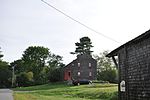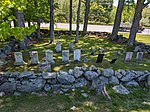Casco Castle was a resort in South Freeport, Maine, United States. Built in 1903, it was intended to resemble a castle. Designed by William R. Miller and overlooking Casco Bay immediately to its east, it burned down in 1914. All that now remains is its 185-foot (56 m) tall stone tower, which is now on private property, inaccessible to the public. The tower can be viewed from Harraseeket Road, a few yards closer to the shoreline, or from Winslow Memorial Park, directly to the south across the Harraseeket River. The main part of the building was to the south, with the tower on its northern side, connected by a bridge.In 1903, Amos F. Gerald, of Fairfield, Maine, built the castle as a resort, with rooms for around one hundred guests, to encourage travel by trolleycars. It was his second attempt; the first, Merrymeeting Park, in Brunswick, Maine, was a failure. The grounds featured a hotel and restaurant, a picnic area, a baseball field, and a small zoo. The hotel burned in 1914, but its stone tower was spared. It stands today on private property. A popular place from which to view the tower is nearby Winslow Memorial Park.Trolleycars of the Portland & Brunswick Street Railway, of which Gerald was general manager, brought visitors from nearby Freeport. After alighting, they crossed 70 foot (21 m) above Spark Creek on a steel suspension bridge, then climbed steep steps to the hotel's entrance.Casco Castle Park was served by the Harpswell Steamboat Company, whose steamers stopped in South Freeport en route to and from Portland and Harpswell Center.The advent of the automobile contributed to the decline of trolley and steamer travel, and the resort closed in 1914 after an eleven-year run. It reopened the same year with new owners, but a fire broke out and destroyed the hotel. The stone tower survived.A photomechanical print of Casco Castle is in the archives of the Metropolitan Museum of Art in New York City.










